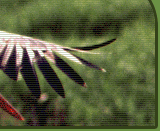| Protected nature area since 1977 Area 1977 - 959 ha; 1999 - 1057 ha; 2004 - 1615 ha Protection status - Nature Reserve
- Natura 2000 site (LV0517000)
Importance in national and EU level Habitats. 7110*, 7140, 7120, 7230, 91D0*, 9080*, 9010*, 6410, 3130 (* priority habitat of EU Habitat Directive Annex I). 10 protected habitats of Latvia. Klani Mire has started to develop as a result the terrestrialization of Klani Lake about 8500 years ago. The intact part of Klani Mire has the typical vegetation of raised bogs with well-developed hummock-hollow complex, lawns and carpets. Flora. Over 530 vascular plant and 158 bryophyte species are known in the site. Protected species of vascular plants and bryophytes: Cypripedium calceolus*, Trichophorum cespitosum, Lobelia dortmanna, Eleocharis multicaulis, Hydrocotyle vulgaris, Litorella uniflora, Nuphar pumila and others (* - species of EU Habitat Directive Annex II) Fauna. There is information about 22 protected bird species of Latvia and EU Bird Directive, for example: Picoides tridactylus, Dendrocopos leucotus, Lanius excubitor, Numenius arquata, Circus aeruginosus, Dryocopus martius and others. Main threats After the drainage the natural outflow of Klani Lake does not exist anymore, the water from the lake flows away along about 2 m wide drainage channel conecting Klani Lake and Busnieku Lake. Vast drainage ditches surround the site and also damage the raised bog habitats the length of drainage ditches reaches 8,5 km. The most damaged area is the southern part of the site where a canal was dug and the drainage of the raised bog was carried out. Planned actions and results: - Elaboration of management plan.
- Preparation of technical designs for building dams.
- Building of dams with the aim to stop degradation of the raised bog habitats.
- Preparation of booklet about the site.
- Establishment and installation of information boards and signs.
- Monitoring of the influence of management actions.
Management plan for Klāņi Mire Pictures from the Klāņi Mires Back to the main project site | 







